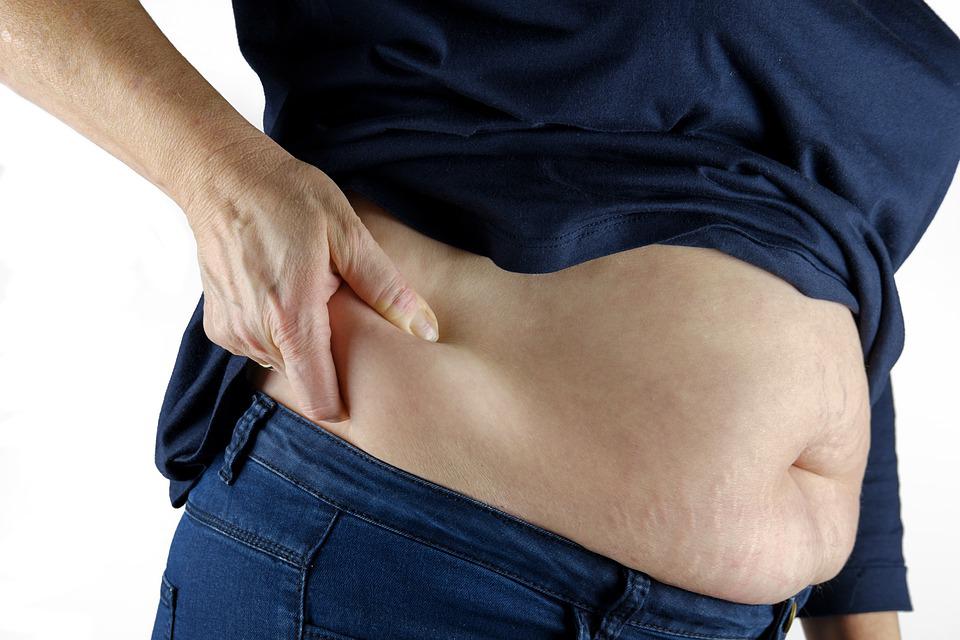A common fitness goal is to lose fat around the belly. A range of exercises and lifestyle changes can help people achieve this.
Many companies that produce pills, drinks, and supplements claim that their products can help you lose weight quickly, get rid of stomach fat, or both.
There is no scientific evidence proving that these products are safe or effective.
One can lose weight and reduce fat through natural methods such as changing the diet and getting specific types of exercise.
The article discusses some ways to lose belly fat without having to resort to medication or surgery. It also looks at the reasons why people may accumulate fat in this area and how this can negatively affect their health.
What makes belly fat different?
Visceral fat is referring to the fat that is around your organs in your abdomen. Having a lot of visceral fat can be harmful to your health and reducing the amount can have some significant benefits.
Visceral fat is a type of fat that is located around the abdominal organs. It is different from subcutaneous fat, which is the type of fat that is found just under the skin. Visceral fat releases hormones that can lead to type 2 diabetes, heart conditions, and other health problems. It is sometimes called “active fat” because of its active role in producing various hormones.
A visible increase in waist circumference can indicate an increase in visceral fat, which is less visible than subcutaneous fat, which sits just below the skin.
The type of fat located in the abdomen area and surrounding the organs is called visceral fat. This type of fat is very responsive to the types of foods a person eats. To reduce the levels of visceral fat, it is important to eat the right types of foods and participate in the right types of exercise.
Don’t be fooled by unrealistic claims of quick weight loss or getting six-pack abs in a short amount of time. Here’s what actually works when it comes to reducing your stomach fat and keeping visceral fat under control.
-
Focus on low calorie foods
Reducing the amount of calories you consume is one of the best ways to lose body fat. When you eat fewer calories than your body burns, you will start to see fat loss in different areas of your body, including your stomach.
A reduced calorie intake will help to burn both visceral and excess subcutaneous fat.
Low calorie foods are often more nutritious than high calorie foods.
Consuming less food that is high in calories and low in nutrition will help create a calorie deficit and improve health.
Try eating healthier foods like fruits, vegetables, pulses, and whole grain foods instead of these foods.
-
Eliminate sugary drinks
A diet high in sugar is thought to be a major factor in weight gain, especially around the stomach.
A high sugar intake could potentially lead to higher levels of visceral fat, due to insulin resistance and inflammation throughout the body.
You can easily consume high levels of sugar without realizing it by drinking beverages such as soda and sweetened tea and coffee.
Many people consume too much sugar by drinking sugary hot drinks and soda. Reducing the amount of sugar in hot drinks and eliminating soda can help these people remove excess sugar from their diets.
-
Go for lean proteins
Foods that are high in protein and low in sugar can help create a feeling of fullness after eating and reduce cravings for sugary snacks. Some examples of these types of foods include nuts, legumes, and lean meats.
Substituting lean meats for fatty meats can help to reduce or eliminate consumption of the latter.
-
Boost overall activity
Increasing your activity level throughout the day will help you burn more calories. This will also help strengthen your muscles and make you feel happier.
Tips for increasing daily activity levels include:
- taking regular stretching breaks when sitting for long periods
- taking the stairs instead of the elevator
- walking or cycling instead of driving or taking public transit
- parking further from a destination
- using a standing desk
-
Try High-Intensity Interval Training (HIIT)
If you want to achieve a flatter stomach, you will need to focus on exercises that burn calories and target your full body. While crunches may strengthen your abdominal muscles, they will not help you lose fat around your waist. To achieve a flatter stomach, you should focus on exercises that burn calories and target your full body.
Not all exercises are equally effective at reducing belly fat, according to Luiza Petre, MD, a cardiologist and weight-management expert.
A September 2019 study published in Mayo Clinic Proceedings found that high-intensity interval training (HIIT) is more effective in reducing abdominal fat than other types of training.
Researchers found that those who performed HIIT lost more inches off their waist, more body fat, and gained more lean muscle mass than those who performed other moderate-intensity exercises, including brisk walking and cycling.
-
Go Mediterranean
Dr. Petre believes that a lower-carbohydrate Mediterranean diet is more effective at reducing belly fat than a diet that is lower in fat. This is because a lower-carb diet will help to blast visceral fat.
We all need to consume fat as part of our diets, but it is important to pay attention to the type of fat we are eating. Those following a Mediterranean diet are typically advised to limit their intake of saturated fats – found in foods like butter, lard, full-fat dairy, fatty meats, fried foods, and commercially baked goods – and to focus on unsaturated fats like olive oil, avocado, and nuts instead.
The Mediterranean diet focuses on whole grains instead of refined carbs, which has been shown to help reduce belly fat. According to Harvard Health Publishing, refined carbs (such as white bread and rice, chips, sweets and sugary drinks) can cause spikes in blood sugar and triglyceride levels, which in turn causes the body to store more fat around the waist.
-
Fuel up on fiber
“Plus, they’re rich in phytochemicals, powerful antioxidants that break down abdominal fat.” Ilana Muhlstein, RD, dietitian and co-creator of Beachbody’s 2B Mindset, recommends cruciferous veggies — such as cabbage, arugula, cauliflower and Brussels sprouts — for blasting belly fat. “They are low in calories but high in fiber,” she explains. “Plus, they’re rich in phytochemicals, powerful antioxidants that break down abdominal fat.”
If you want to lose weight, one way to do it is to eat more fiber. Fiber makes you feel full on less food, which means you end up eating less overall. Soluble fiber, in particular, may be effective in reducing abdominal fat. One study found that for each 10-gram increase in soluble fiber intake, belly fat accumulation decreased by 3.7 percent.
Muhlstein says that you shouldn’t worry too much about how much fiber you’re eating each day, and that you should instead focus on filling your plate with a variety of vegetables as often as possible.
-
Choose healthful fats
You need some dietary fat in a healthy diet, but not all fat sources are good for you.
Eating too much saturated fat and trans fat can be harmful to the heart, increasing the risk of heart disease and stroke. They can also lead to weight gain and are closely linked with the development of visceral fat.
Replace unhealthy fats in your diet with healthier options to decrease body fat and improve your health.
Healthful high fat foods include:
- avocados
- chia seeds
- eggs
- fatty fish
- nuts and nut butters
- olives
-
Eat fewer refined carbs
Carbs that have been refined are not nutritionally dense but are high in calories. You can find these kinds of carbs in white bread, grains that have been processed, and sugary snacks and beverages.
Refined carbs have been linked to the development of abdominal fat.
You can improve your diet by replacing refined carbohydrates with complex carbohydrates. These are found in fruits, vegetables, and whole grain foods.
-
Prioritize sleep
Dr. Petre has found that there is a link between sleep and the amount of visceral fat a person has. A study published in 2014 found that people who slept for seven to eight hours a day gained less visceral fat than those who slept for less or more time.
The stress hormone cortisol is partly to blame for weight gain when you don’t get enough sleep. Cortisol signals your body to store more fat in your belly, increases your hunger, and slows your metabolism.
-
Slay stress
This research suggests that higher stress levels are linked to more visceral fat. Visceral fat is the fat that clings to your body and grows your fat cells.
While you can’t control everything in your environment, you can control how you react to it, which can help reduce the impact of stress on your body.
-
Try cardio
Cardio exercise is good for the heart and lungs. It also helps to burn calories and reduce body fat.
Some cardio exercises include:
- walking
- running
- using an exercise bike
- swimming
-
Try strength training
Strengthening your muscles through weight training can help reduce your overall body weight. This is because muscle mass burns more calories than fat tissue.
Regular strength training can help to improve bone and joint health by building stronger muscles which can better support the body, reducing strain on bones and joints.
The CDC recommends doing strength training at least 2 days per week.
Understanding Belly Fat
When trying to lose weight, it is important to understand the difference between belly fat and other types of body fat. This will help to determine the best plan for weight loss.
Types of Belly Fat
There are two types of belly fat:
It’s also the most worrisome type of fat, increasing the risk of heart disease and diabetes. The “hard” kind of fat that lies deep inside the abdomen and surrounds our organs is called “visceral fat.” This type of fat is responsible for the protruding “beer belly” look. Visceral fat is also the most worrisome type of fat because it increases the risk of heart disease and diabetes.
Subcutaneous fat is the soft kind of fat that you can pinch, and it resides in the layer beneath the skin’s surface.
Dr. Petre says that as we age and our hormones change, we tend to deposit more visceral fat. Visceral fat is very pro-inflammatory and much more dangerous to our health than subcutaneous fat.
Tip
A waist circumference over 35 inches for women and over 40 inches for men is an indication of excess visceral fat, according to the National Institutes of Health.
How We Lose Belly Fat
The process of weight loss occurs evenly throughout the body, according to Dr. Petre. This means that fat is burned at the same rate throughout the body, rather than in specific areas.
The focal weight loss is not actually a loss of weight, but a sign of how our fat is distributed. According to the text, women store more fat around the thighs and hips, while men carry more fat around the waist. So, when weight loss occurs, it is more visible in those areas.
The body breaks down visceral fat more readily to use as fuel, per Harvard Health Publishing, so it responds to diet and exercise more efficiently than soft fat on, say, the hips and thighs.
How fast can you lose belly fat?
The time it takes for you to see your stomach getting smaller depends on how many calories you’re taking in compared to how many you’re burning.
Losing belly fat requires consuming fewer calories than you burn. Most people can cut 500-1000 calories from their diet each day, which leads to 1-2 pounds of weight loss each week, according to the Mayo Clinic. However, women shouldn’t consume fewer than 1200 calories per day, and men shouldn’t consume fewer than 1500 calories per day, unless under doctor supervision.
If you follow the schedule, you will start to see results in two weeks, says Holly Roser, a certified personal trainer and nutritionist.
Factors that Contribute to Belly Fat
People tend to develop larger amounts of visceral fat if they consume diets high in processed and sugary foods.
As people get older, they tend to accumulate more fat around their waist, especially women. Some health conditions can also cause an increase in visceral fat.
Summary
There are many health benefits to reducing abdominal fat. People can achieve this by eating a healthy diet and exercising regularly.







